
Serial Self-Portraits in the Work of
Elisabeth Vigee Le Brun
Kathleen Russo,Phd, Florida Atlantic University
Presented in 1996, Amsterdam
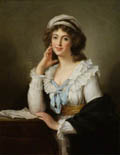 The eighteenth century witnessed a growing legion of professional women artists who competed with their male colleagues and each other for patronage and positions in the prestigious academies. This resulted in restrictions on female memberships in many institutions and a ban altogether in the French Royal Academy, which voted in 1706 to no longer admit women. Although this was eventually modified to include a maximum of four female academicians, the opportunities for women to achieve the fame and fortune of their male contemporaries was limited, and was made even moreso by their inability to train in the academic schools or attend life drawing classes. Even so, there were a number of eighteenth century women artists that became known for their talent, teaching, stylistic innovations, influence on other artists, and professional prosperity. Nowhere can this be better seen than in the life and work of the French painter Elisabeth Vigee Le Brun.
The eighteenth century witnessed a growing legion of professional women artists who competed with their male colleagues and each other for patronage and positions in the prestigious academies. This resulted in restrictions on female memberships in many institutions and a ban altogether in the French Royal Academy, which voted in 1706 to no longer admit women. Although this was eventually modified to include a maximum of four female academicians, the opportunities for women to achieve the fame and fortune of their male contemporaries was limited, and was made even moreso by their inability to train in the academic schools or attend life drawing classes. Even so, there were a number of eighteenth century women artists that became known for their talent, teaching, stylistic innovations, influence on other artists, and professional prosperity. Nowhere can this be better seen than in the life and work of the French painter Elisabeth Vigee Le Brun.
Elisabeth Vigee Le Brun was one of the most successful and prolific portrait painters in history. By her own estimate, she executed over nine hundred works during her eightyseven-year life, which spanned from 1755-1842. These works included history paintings, as well as landscapes, but the majority were beautifully colored, deftly rendered, idealized likenesses of the most prominent aristocrats of her time. Her most important patron was the much maligned Queen of France, Marie Antoinette. Vigee Le Brun painted over twenty portraits of this Austrian-born monarch, beginning in 1778 and ending with the artist's own exile from France on the night the king and queen were taken prisoner by a Revolutionary mob on October 6, 1789. Two of her best known portraits of the queen, both located at Versailles, are Marie Antoinette Holding a Rose (I 784) and Marie Antoinette with Her Children (1787). The individual likeness, with its casual elegance and lush landscape background, is more typical of VigeeLe Brun's portraits, but the family grouping was one of her largest and best-known paintings. It was commissioned by the state government for propagandistic purposes because the public hated the queen and regarded her as a bad mother. Here Vigee Le Brun has promoted the Rousseauian ideal of a happy family, an image that the artist would later embrace in her own self-portraits.The elaborate and elegant clothing worn in both of these portraits of Marie Antoinette was
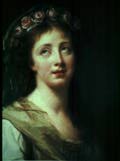 not in keeping with the personal taste of the artist. In her published Souvenirs, written when she was in her eighties, Vigee Le Brun states: "I detested the female style of dress then in fashion, I bent all my efforts upon rendering it a little more picturesque, and was delighted when, after getting the confidence of my models, I was able to drape them according to my fancy. One sees this "fancy" in her most controversial portrait called Marie Antoinette en Gaulle (1 783), the term used to indicate the softly flowing muslin dress tied high at the waist worn here by the queen. The patron also sports a straw hat adorned with feathers and a bow, and again holds her symbol, the rose. This work caused a scandal when exhibited at the Salon of 1783 and the artist was forced to withdraw the picture only a few days after the exhibition opened. Critics protested that the queen looked indecent and unregal, but in fact the artist was just reflecting a newly-emerging, more "natural" style she herself popularized. not in keeping with the personal taste of the artist. In her published Souvenirs, written when she was in her eighties, Vigee Le Brun states: "I detested the female style of dress then in fashion, I bent all my efforts upon rendering it a little more picturesque, and was delighted when, after getting the confidence of my models, I was able to drape them according to my fancy. One sees this "fancy" in her most controversial portrait called Marie Antoinette en Gaulle (1 783), the term used to indicate the softly flowing muslin dress tied high at the waist worn here by the queen. The patron also sports a straw hat adorned with feathers and a bow, and again holds her symbol, the rose. This work caused a scandal when exhibited at the Salon of 1783 and the artist was forced to withdraw the picture only a few days after the exhibition opened. Critics protested that the queen looked indecent and unregal, but in fact the artist was just reflecting a newly-emerging, more "natural" style she herself popularized.
Vigee-Lebrun had far greater freedom when painting her own self-portraits, an enterprise in which she was often engaged. Close to forty self-portraits are attributed to her, although many of these were autographed copies of existing originals. This tendency to paint several versions of the same composition was typical of the time and in no way detracted from the importance of the work. Since other artists also did copies of her more admired works, however, many versions of the same painting may be available for study.Vigee-Lebrun's self-portraits have met
 with a wide range of critical response from the time they were painted to the present day. Her cohtemporary, Grimm, called them "brilliantly graceful," while Michael Levey and Simone de Beauvoir have dubbed them narcissistic. The feminists Parker and Pollock consider them inappropriate representations of a professional woman, while Boime refers to them as both "spontaneous" and "superficial." Sheriff calls them "skillful artistic performances dependent on the ability to mimic signifying codes, gestures and styles,"while Baillio points out their introduction of a "more natural" look. No one has called them "ugly" or "badly painted" and a look at her
more important selfportraits easily demonstrates why this is the case. The self-portraits of Vigee-Lebrun are undoubtedly some of the most beautiful and richly colored visual images ever painted, making them important for inclusion in any visual resources archives They also document and reflect the dramatic changes that took place both politically and stylistically during the latter part of the eighteenth century, as will be shown, as well as being a personal evocation of one of the most successful women artists in history. with a wide range of critical response from the time they were painted to the present day. Her cohtemporary, Grimm, called them "brilliantly graceful," while Michael Levey and Simone de Beauvoir have dubbed them narcissistic. The feminists Parker and Pollock consider them inappropriate representations of a professional woman, while Boime refers to them as both "spontaneous" and "superficial." Sheriff calls them "skillful artistic performances dependent on the ability to mimic signifying codes, gestures and styles,"while Baillio points out their introduction of a "more natural" look. No one has called them "ugly" or "badly painted" and a look at her
more important selfportraits easily demonstrates why this is the case. The self-portraits of Vigee-Lebrun are undoubtedly some of the most beautiful and richly colored visual images ever painted, making them important for inclusion in any visual resources archives They also document and reflect the dramatic changes that took place both politically and stylistically during the latter part of the eighteenth century, as will be shown, as well as being a personal evocation of one of the most successful women artists in history.  The great Flemish master Peter Paul Rubens had a profound impact on Vigee-Lebrun's color, glazing techniques, compositional approach, and use of light. She made copies after his Medici Cycle in the Luxembourg Palace while still a teenager, but was particularly impressed with works she viewed on a trip to Flanders with her art dealer husband, J.B.P. Lebrun, in 1781. When she returned home she painted two self-portraits under Rubens influence.
The great Flemish master Peter Paul Rubens had a profound impact on Vigee-Lebrun's color, glazing techniques, compositional approach, and use of light. She made copies after his Medici Cycle in the Luxembourg Palace while still a teenager, but was particularly impressed with works she viewed on a trip to Flanders with her art dealer husband, J.B.P. Lebrun, in 1781. When she returned home she painted two self-portraits under Rubens influence.
The first of these was a Self-Portrait with Cerise Ribbon (Kimball, 1782) painted when she was twenty-seven years old. Here she wears a white muslin Robe en Gaulle with a cherryred ribbon and bow, a black shawl, and a plumed hat-attire similar to that in which the queen posed one year later, as has already been discussed. The softly flowing,
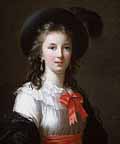 unpowdered hair favored by the artist, which she says she did herself (her mother was a hairdresser of peasant stock), contributes to what she described as "a fresh appearance proper to youth. She also depicts herself as extremely pretty, a fact mentioned by almost every contemporary commenting on her. Her nephew Justin Tripier Le Franc described her as being blonde, blue-eyed, tall, well built, and with a majestic bearing, a trait she herself particularly admired in Marie Antoinette. Other contemporaries praised her wit, grace, and charm-all qualities much appreciated in the Paris of the Ancien Regime and captured in this youthful Self-Portrait. What she has not stressed in this work is her role as an artist, a profession at which she had at this time been working for twelve years, since she began her career at fifteen. She quickly was making so much money that she gained the attention of the law and was threatened with arrest for working without a license. To remedy this situation she joined the Academie Saint-Luc in 1774, where she regularly exhibited her works. it was in 1783, a year after this work was painted, that she was made a member of the Royal Academy. Thus, she was a well-established professional woman by the time she executed this rather sensual, smiling image of herself. unpowdered hair favored by the artist, which she says she did herself (her mother was a hairdresser of peasant stock), contributes to what she described as "a fresh appearance proper to youth. She also depicts herself as extremely pretty, a fact mentioned by almost every contemporary commenting on her. Her nephew Justin Tripier Le Franc described her as being blonde, blue-eyed, tall, well built, and with a majestic bearing, a trait she herself particularly admired in Marie Antoinette. Other contemporaries praised her wit, grace, and charm-all qualities much appreciated in the Paris of the Ancien Regime and captured in this youthful Self-Portrait. What she has not stressed in this work is her role as an artist, a profession at which she had at this time been working for twelve years, since she began her career at fifteen. She quickly was making so much money that she gained the attention of the law and was threatened with arrest for working without a license. To remedy this situation she joined the Academie Saint-Luc in 1774, where she regularly exhibited her works. it was in 1783, a year after this work was painted, that she was made a member of the Royal Academy. Thus, she was a well-established professional woman by the time she executed this rather sensual, smiling image of herself.
 Although she did not include references to her profession in the work just discussed, she did do so in the second, and more obvious, self-portrait that she painted under the influence of Rubens. Called Self-Portrait with Straw Hat - 1783 (National Gallery, London), this work directly references Ruben's portrait of Susannah Fourment. Vigee-Lebrun tells us in her Souvenirs that she saw this work in Antwerp and that it delighted and inspired me to such a degree that I made a portrait of myself at Brussels, striving to obtain the same effects. It is important to note that in discussing the reasons she was so impressed by Ruben's work, she emphasized his technical approach saying, "The force lies in the two different lights-those of the sun, and of the reflected sunlight ... Perhaps one must be a painter in order to appreciate all the power here displayed by Rubens." She has herself emphasized the lights and shadows as reflected in the outdoor atmosphere captured in this self-portrait.
Mary Sheriff has recently published a provocative and original analysis of Vigee-Lebrun's work generally, and this 1783 Self-Portrait specifically, under the title The Exceptional Woman (University of Chicago Press, 1996). Sheriff concludes that in her Self-Portrait with Straw Hat, Vigee-Lebrun identifies as an "intimate of the Queen, the painter Rubens, his beloved wife (since Vigee-Lebrun thought Susannah Fourment was Ruben's wife), a painted figure made by Rubens, a history painter, a hermaphrodite, an inspired artist, an intellectual making a reasoned point (rhetorical gesture), a speaking subject, a beautiful woman, an objectified commodity (sex object), an immodest woman/artist pleasuring in selfdisplay. Although Vigee-Lebrun would probably jostle the palette
Although she did not include references to her profession in the work just discussed, she did do so in the second, and more obvious, self-portrait that she painted under the influence of Rubens. Called Self-Portrait with Straw Hat - 1783 (National Gallery, London), this work directly references Ruben's portrait of Susannah Fourment. Vigee-Lebrun tells us in her Souvenirs that she saw this work in Antwerp and that it delighted and inspired me to such a degree that I made a portrait of myself at Brussels, striving to obtain the same effects. It is important to note that in discussing the reasons she was so impressed by Ruben's work, she emphasized his technical approach saying, "The force lies in the two different lights-those of the sun, and of the reflected sunlight ... Perhaps one must be a painter in order to appreciate all the power here displayed by Rubens." She has herself emphasized the lights and shadows as reflected in the outdoor atmosphere captured in this self-portrait.
Mary Sheriff has recently published a provocative and original analysis of Vigee-Lebrun's work generally, and this 1783 Self-Portrait specifically, under the title The Exceptional Woman (University of Chicago Press, 1996). Sheriff concludes that in her Self-Portrait with Straw Hat, Vigee-Lebrun identifies as an "intimate of the Queen, the painter Rubens, his beloved wife (since Vigee-Lebrun thought Susannah Fourment was Ruben's wife), a painted figure made by Rubens, a history painter, a hermaphrodite, an inspired artist, an intellectual making a reasoned point (rhetorical gesture), a speaking subject, a beautiful woman, an objectified commodity (sex object), an immodest woman/artist pleasuring in selfdisplay. Although Vigee-Lebrun would probably jostle the palette
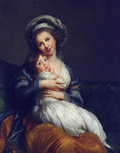 and brushes inscribed on her tombstone at the hermaphroditic association (a reference to her talent and success in the maledominated art world), Sheriff has well captured the abundant sources and references inherent in this work, a work that the artist tells us "added considerably" to her reputation when exhibited in the Salon of 1783. It was Raphael that inspired the next major Self-Portrait of the Artist (Louvre, 1786). No longer the youthful ingenue or the self-confident professional with palette and brushes in . hand, Vigee-Lebrun is now the devoted mother in keeping with the new age of "sensibility" influenced by Jean Jacques Rousseau. In the spirit of Raphael's Madonna of the Chair, the artist embraces her daughter Julie, who was probably named after the heroine of Rousseau's most famous novel (the most widely read of the late eighteenth century). It is significant that in portraying herself as a mother, Vigee-Lebrun has forged new ground in the realm of the female self-portrait, While women artists had a long history of reflecting their roles as stylish and learned ladies or working professionals at their easels with palettes, they heretofore eschewed a maternal emphasis, perhaps for fear of not being taken seriously as artists. By this time, however, Vigee-Lebrun was being paid more for her portraits than any other artist, including Gainesborough. The plethora of commissions given to her were satisfied because she worked all day, every day, with few interruptions. She credits a day rest she called her "calm" with giving her the endurance to work as long and hard as she did for so many years. Thus, she had the confidence to show herself in the sentimental role of mother without worrying about her professional position.
and brushes inscribed on her tombstone at the hermaphroditic association (a reference to her talent and success in the maledominated art world), Sheriff has well captured the abundant sources and references inherent in this work, a work that the artist tells us "added considerably" to her reputation when exhibited in the Salon of 1783. It was Raphael that inspired the next major Self-Portrait of the Artist (Louvre, 1786). No longer the youthful ingenue or the self-confident professional with palette and brushes in . hand, Vigee-Lebrun is now the devoted mother in keeping with the new age of "sensibility" influenced by Jean Jacques Rousseau. In the spirit of Raphael's Madonna of the Chair, the artist embraces her daughter Julie, who was probably named after the heroine of Rousseau's most famous novel (the most widely read of the late eighteenth century). It is significant that in portraying herself as a mother, Vigee-Lebrun has forged new ground in the realm of the female self-portrait, While women artists had a long history of reflecting their roles as stylish and learned ladies or working professionals at their easels with palettes, they heretofore eschewed a maternal emphasis, perhaps for fear of not being taken seriously as artists. By this time, however, Vigee-Lebrun was being paid more for her portraits than any other artist, including Gainesborough. The plethora of commissions given to her were satisfied because she worked all day, every day, with few interruptions. She credits a day rest she called her "calm" with giving her the endurance to work as long and hard as she did for so many years. Thus, she had the confidence to show herself in the sentimental role of mother without worrying about her professional position.
 The dryer, more linear style of this work, with its flatter application of paint, reflects the nascent Neoclassical movement in France. She would truly embrace this new stylistic trend in yet another depiction of herself with her daughter (1789,Louvre) painted two years later. " This famous work is acknowledged as a dramatic early example of changing taste. Even Levey, who speaks quite disparagingly of Vigee-Lebrun, credits her with creating a new approach to portraiture." David's famous Madame de Recamier, painted eleven years later, bears a great stylistic similarity to this work. Vigee-Lebrun was well acquainted with David, but the two staunchly disagreed politically. Madame de Recamier went into exile due to a falling out with Napoleon and, coincidentally, was at Madame de Stael's when VigeeLebrun was painting that famous author's portrait at her chateau on Lake Geneva. Vigee-Lebrun spent twelve years in exile following her 1789 flight from Paris. During this time she was welcomed throughout Europe and Russia, where she continued to be deluged with portrait commissions and was made a member of most of the major art academies. In Florence, she was asked to contribute a Self-Portrait to the Grand Ducal Gallery of the Uffizi, the Grand Duke at the time being Marie Antoinette's brother. In this work, actually painted in Rome in 1790, she not only emphasizes her role as a professional artist, at her easel with brushes and palette in hand, but she underscores her formerly important position as painter to the queen by
The dryer, more linear style of this work, with its flatter application of paint, reflects the nascent Neoclassical movement in France. She would truly embrace this new stylistic trend in yet another depiction of herself with her daughter (1789,Louvre) painted two years later. " This famous work is acknowledged as a dramatic early example of changing taste. Even Levey, who speaks quite disparagingly of Vigee-Lebrun, credits her with creating a new approach to portraiture." David's famous Madame de Recamier, painted eleven years later, bears a great stylistic similarity to this work. Vigee-Lebrun was well acquainted with David, but the two staunchly disagreed politically. Madame de Recamier went into exile due to a falling out with Napoleon and, coincidentally, was at Madame de Stael's when VigeeLebrun was painting that famous author's portrait at her chateau on Lake Geneva. Vigee-Lebrun spent twelve years in exile following her 1789 flight from Paris. During this time she was welcomed throughout Europe and Russia, where she continued to be deluged with portrait commissions and was made a member of most of the major art academies. In Florence, she was asked to contribute a Self-Portrait to the Grand Ducal Gallery of the Uffizi, the Grand Duke at the time being Marie Antoinette's brother. In this work, actually painted in Rome in 1790, she not only emphasizes her role as a professional artist, at her easel with brushes and palette in hand, but she underscores her formerly important position as painter to the queen by
 showing an unfinished likeness of Marie Antoinette on her easel." When she later made one of her customary autographed copies of this work, she changed the subject being painted from Marie Antoinette to her daughter Julie (National Trust, Suffolk), perhaps for political reasons for she longed to return to her home city. The easel image was again changed in a print executed by her friend Vivant-Denon when she visited him in Venice in 1792. It is now Raphael who is captured by her brush, a reference to her admiration for the great Renaissance master, but also signifying the fact that with her Uffizi Self-Portrait she would take her place among the great artists in history, including Raphael. Her contemporary Angelica Kauffmann also had a Self-Portrait in the Uffizi, which Vigee-Lebrun praised on her visit there.(14) She later met Kauffmann in Rome and called her intelligent and knowledgeable. However, she somewhat cattily adds that she was about fifty (she was fortyeight) and frail, due to being ruined by the Swedish adventurer whom she married." Vigee-Lebrun could empathize with Kauffmann's situation since her own husband was a gambler and womanizer who had spent all her money. He then divorced her while she was in exile so his property would not be confiscated. At least in exile Vigee-Lebrun could keep the fortune she amassed from her work, which she would later use to buy her ex-husband's property for herself. It was her husband who originally encouraged her to train students in order to make an even greater income. She did this reluctantly and complained about the time that teaching took away from her own work. This was not the case with her formidable rival Adelaide Labille-Guiard, who stressed this role in her own Self-Portrait With Two Female Students (Metropolitan Museum of Art New York, 1785). Vigee-Lebrun and Labille-Guiard, admitted to the Academy on the same day, were constantly compared to each other professionally. (16) As has already been observed by others, in casting the two women as rivals, it avoided the issue of comparing their works with their male contemporaries. Vigee-Lebrun was also often compared to another successful female painter, Rosalba Carriera (1675-1757). Carriera painted eight self-portraits including a pastel for the Grand Ducal Gallery of The Uffizi where she holds a portrait of her sister. Rosalba's fame was in popularizing the pastel medium for finished paintings rather than studies. Her work had a tremendous impact on French art during her stay in Paris from 1720-2 1. For the rest of the century pastels would be a favorite medium for French artists, including Vigee-Lebrun's father Louis Vigee. Although her father died when she was only
showing an unfinished likeness of Marie Antoinette on her easel." When she later made one of her customary autographed copies of this work, she changed the subject being painted from Marie Antoinette to her daughter Julie (National Trust, Suffolk), perhaps for political reasons for she longed to return to her home city. The easel image was again changed in a print executed by her friend Vivant-Denon when she visited him in Venice in 1792. It is now Raphael who is captured by her brush, a reference to her admiration for the great Renaissance master, but also signifying the fact that with her Uffizi Self-Portrait she would take her place among the great artists in history, including Raphael. Her contemporary Angelica Kauffmann also had a Self-Portrait in the Uffizi, which Vigee-Lebrun praised on her visit there.(14) She later met Kauffmann in Rome and called her intelligent and knowledgeable. However, she somewhat cattily adds that she was about fifty (she was fortyeight) and frail, due to being ruined by the Swedish adventurer whom she married." Vigee-Lebrun could empathize with Kauffmann's situation since her own husband was a gambler and womanizer who had spent all her money. He then divorced her while she was in exile so his property would not be confiscated. At least in exile Vigee-Lebrun could keep the fortune she amassed from her work, which she would later use to buy her ex-husband's property for herself. It was her husband who originally encouraged her to train students in order to make an even greater income. She did this reluctantly and complained about the time that teaching took away from her own work. This was not the case with her formidable rival Adelaide Labille-Guiard, who stressed this role in her own Self-Portrait With Two Female Students (Metropolitan Museum of Art New York, 1785). Vigee-Lebrun and Labille-Guiard, admitted to the Academy on the same day, were constantly compared to each other professionally. (16) As has already been observed by others, in casting the two women as rivals, it avoided the issue of comparing their works with their male contemporaries. Vigee-Lebrun was also often compared to another successful female painter, Rosalba Carriera (1675-1757). Carriera painted eight self-portraits including a pastel for the Grand Ducal Gallery of The Uffizi where she holds a portrait of her sister. Rosalba's fame was in popularizing the pastel medium for finished paintings rather than studies. Her work had a tremendous impact on French art during her stay in Paris from 1720-2 1. For the rest of the century pastels would be a favorite medium for French artists, including Vigee-Lebrun's father Louis Vigee. Although her father died when she was only 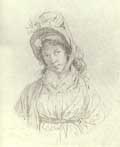 twelve, VigeeLebrun would herself often work in pastels. One such example is the 1790 Self-Portrait she executed during her first year of exile (private collection). There is an uncharacteristic hint of melancholy in this work, although any real melancholia was totally against her nature. She was described by all who knew her as cheerful, optimistic, and witty, even in times of personal adversity and stress. This nature no doubt contributed to the lack of psychological penetration of her subjects, including herself, for which she is
often criticized. Rembrandt she was not, even though she had copied his works as part of her training. She was more indebted to the sweet sentimentality of Greuze (for example: The Milkmaid, Louvre) and advised her students, including her nieces, to pay careful attention to Greuze's heads." To restrict comparison of Vigee-Lebrun's work to other successful women painters of the period, or to the more sentimental (feminine) aspects of Greuze's work, however, would be very narrow-minded. Her works also relate strongly to those of David, as has already been shown in the compari'son of her Self-Portrait with Her Daughter with the portrait of Madame de Recamier. As Baillio has already pointed out, David's Madame Seriziat and her Son was also deeply indebted to
this work."' A comparison of a Vigee-Lebrun Self-Portrait drawing, 1800 (Pierpont Morgan Library, New York) with a drawing by David's student Ingres (Count Turpin) illustrates once again that the works of VigeeLebrun strongly relate to those of later Neoclassical artists and, in fact, probably influenced them. David, when comparing a portrait he had done with one executed by Vigee-Lebrun, said that his work looked like the one done by the woman and hers the one done by the man, a comment that Vigee-Lebrun took as a compliment and was fond of repeating. Why one may ask, should this have been and still often be the case? Vigee-Lebrun was not a man, and not a hermaphrodite, nor a brooding melancholy spirit as were both David and Ingres. She was a pretty, optimistic, diligent, witty, society portrait painter working before and after the French Revolution. Very appropriately, this is the person captured in the many self-portraits painted by her. twelve, VigeeLebrun would herself often work in pastels. One such example is the 1790 Self-Portrait she executed during her first year of exile (private collection). There is an uncharacteristic hint of melancholy in this work, although any real melancholia was totally against her nature. She was described by all who knew her as cheerful, optimistic, and witty, even in times of personal adversity and stress. This nature no doubt contributed to the lack of psychological penetration of her subjects, including herself, for which she is
often criticized. Rembrandt she was not, even though she had copied his works as part of her training. She was more indebted to the sweet sentimentality of Greuze (for example: The Milkmaid, Louvre) and advised her students, including her nieces, to pay careful attention to Greuze's heads." To restrict comparison of Vigee-Lebrun's work to other successful women painters of the period, or to the more sentimental (feminine) aspects of Greuze's work, however, would be very narrow-minded. Her works also relate strongly to those of David, as has already been shown in the compari'son of her Self-Portrait with Her Daughter with the portrait of Madame de Recamier. As Baillio has already pointed out, David's Madame Seriziat and her Son was also deeply indebted to
this work."' A comparison of a Vigee-Lebrun Self-Portrait drawing, 1800 (Pierpont Morgan Library, New York) with a drawing by David's student Ingres (Count Turpin) illustrates once again that the works of VigeeLebrun strongly relate to those of later Neoclassical artists and, in fact, probably influenced them. David, when comparing a portrait he had done with one executed by Vigee-Lebrun, said that his work looked like the one done by the woman and hers the one done by the man, a comment that Vigee-Lebrun took as a compliment and was fond of repeating. Why one may ask, should this have been and still often be the case? Vigee-Lebrun was not a man, and not a hermaphrodite, nor a brooding melancholy spirit as were both David and Ingres. She was a pretty, optimistic, diligent, witty, society portrait painter working before and after the French Revolution. Very appropriately, this is the person captured in the many self-portraits painted by her.
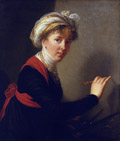 She was also a hard working professional artist much appreciated for her talent. This is also the focus of many of her self-portraits, including later works done for St. Petersburg (1800). Was she vain about both her looks and talent? Undoubtedly! But so were Quentin de la Tour, Courbet, and a host of other male artists. It appears from almost all accounts that she had justification for her vanity, which was certainly well founded with regards to her professional success. This was well acknowledged by her contemporaries. When Sir Joshua Reynolds, Director of the British Royal Academy, was asked what he thought of her works, he said that they were as good as any by painters either living or dead. When asked incredulously by his student Northcote if that included Van Dyck, the seventeenth-century Flemish portrait painter par excellence, he answered yes. (19)
She was also a hard working professional artist much appreciated for her talent. This is also the focus of many of her self-portraits, including later works done for St. Petersburg (1800). Was she vain about both her looks and talent? Undoubtedly! But so were Quentin de la Tour, Courbet, and a host of other male artists. It appears from almost all accounts that she had justification for her vanity, which was certainly well founded with regards to her professional success. This was well acknowledged by her contemporaries. When Sir Joshua Reynolds, Director of the British Royal Academy, was asked what he thought of her works, he said that they were as good as any by painters either living or dead. When asked incredulously by his student Northcote if that included Van Dyck, the seventeenth-century Flemish portrait painter par excellence, he answered yes. (19)
Notes
1.The number 900 is quoted by Eleanor Tufts in Our Hidden Heritage (London: Paddington Press, 1974), p. 132. More recent estimates are at 1,000. According to Karen Peterson and J.J. Wilson in Women Artists,(New York: New York University Press, 1976), 53, 660 of these were portraits. Tufts (p. 132) says that 200 were landscapes.
2. Elisabeth Vigee-Lebrun, Memoirs of Madame Vigcse-Lebrun, translated by Lionel Strachey (New York: George Braziller, 1989), 22.
3. Mary Sheriff, The Exceptional Woman (Chicago and London: University of Chicago Press, 1996), 21 5.
4. Vigee-Lebrun, Memoirs, 8.
5. Joseph Baillio, Elisabetti Louise Vigee-Lebrun) 1755-1842 (Fort
Worth: Kimball Art Museum), 1982), 44.
6. Vigee-Lebrun, Memoirs, 34.
7. W. H. Heim, Vigee-Lebrun 1755-1842: Her Life, Works and
Friendships (Boston: Small, Maynard and Co., 1915), 38.
8. Sheriff, Exceptional Woman, 214.
9. This work was first exhibited in the Salon de la Correspondence in 1782. The original painting was in the collection of her rumored lover the Comte de Vaudreuil and is now in a private Swiss collection. An autographed copy is in the National Gallery, London.
I 0. Julie Lebrun (I 780-1819) was nine years old at this time.
11. This work was commissioned by D'Angiviller, The Director of Royal Buildings.
12. Michael Levey, Painting and Sculpture in France, 1700-1789 (New Haven and London: Yale University Press, 1993), 282.
13. She had already utilized this same composition in the portrait of her friend, the Marquise de Grollier, a flower painter. See Baillio, Vigee Lebrun, 76.
14. Four hundred and fifteen self-portraits are on view in the Uffizi, while over 1,000 are in storage. See Luciano Berti, Uffizi (Florence, 1974), 134.
15. Heim, Vigeee-Lebrun, 1 1 0.
16. In 1782 they both exhibited self-portraits at the Salon de la CorrL-.sporideice arid their works were often hung next to each other at Salon shows.
17. Vigee-Lebrun studied with Greuze and made many copies after his work.
18. Baillio, Vigee-Lebrun, 10.
19. ibid, 63.
|











